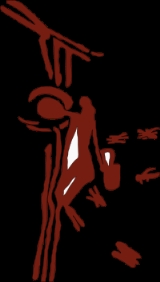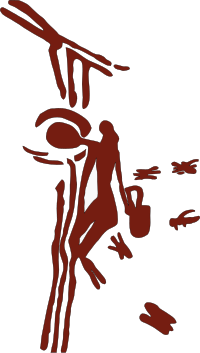
Honey hunting
Encyclopedia
Honey hunting or honey harvesting which involves robbing honey
from wild bee
colonies is one of the most ancient human activities and is still practiced by aboriginal societies in parts of Africa
, Asia
, Australia
and South America
. Some of the earliest evidence of gathering honey from wild colonies is from rock painting
, dating to around 13,000 BC
. Robbing honey from wild bee colonies is usually done by subduing the bees with smoke
and breaking open the tree or rocks where the colony is located, often resulting in the physical destruction of the colony.

is a part of the indigenous culture in many parts and hunters have hunted for thousands of years.
on the Honey hunters of Nepal documents Gurung
tribesmen of west-central Nepal
entering the jungle in search of wild honey
where they use indigenous tools under precarious conditions to collect honey.
Twice a year high in the Himalayan foothills of central Nepal teams of men gather around cliffs that are home to the world's largest honeybee, Apis laboriosa
. As they have for generations, the men come to harvest the Himalayan cliff bee's honey.
This was also documented in a BBC2 documentary in August 2008 entitled Jimmy and the Wild Honey Hunters-Sun. An English farmer travelled into the Himalayan foothills on a honey hunting expedition. The world's largest honeybee, Apis laboriosa
is over twice the size of those in the UK
where their larger bodies have adapted to the colder climate for insulation. The documentary involved ascending a 200 foot rope ladder and balancing a basket and a long pole to chisel away at a giant honey comb of up to 2 million bees and catch it in the basket.
and Bangladesh
, estuarine
forests are the area of operation of honey hunters. They are known as "Mawals". This is a dangerous occupation as many honeyhunters die in tiger attacks which are common in this area. The harvest ritual, which varies slightly from community to community, begins with a prayer and sacrifice of flowers, fruits, and rice. Then a fire is lit at the base of the cliff to smoke the bees from their honeycombs.
Honey
Honey is a sweet food made by bees using nectar from flowers. The variety produced by honey bees is the one most commonly referred to and is the type of honey collected by beekeepers and consumed by humans...
from wild bee
Bee
Bees are flying insects closely related to wasps and ants, and are known for their role in pollination and for producing honey and beeswax. Bees are a monophyletic lineage within the superfamily Apoidea, presently classified by the unranked taxon name Anthophila...
colonies is one of the most ancient human activities and is still practiced by aboriginal societies in parts of Africa
Africa
Africa is the world's second largest and second most populous continent, after Asia. At about 30.2 million km² including adjacent islands, it covers 6% of the Earth's total surface area and 20.4% of the total land area...
, Asia
Asia
Asia is the world's largest and most populous continent, located primarily in the eastern and northern hemispheres. It covers 8.7% of the Earth's total surface area and with approximately 3.879 billion people, it hosts 60% of the world's current human population...
, Australia
Australia
Australia , officially the Commonwealth of Australia, is a country in the Southern Hemisphere comprising the mainland of the Australian continent, the island of Tasmania, and numerous smaller islands in the Indian and Pacific Oceans. It is the world's sixth-largest country by total area...
and South America
South America
South America is a continent situated in the Western Hemisphere, mostly in the Southern Hemisphere, with a relatively small portion in the Northern Hemisphere. The continent is also considered a subcontinent of the Americas. It is bordered on the west by the Pacific Ocean and on the north and east...
. Some of the earliest evidence of gathering honey from wild colonies is from rock painting
Cave painting
Cave paintings are paintings on cave walls and ceilings, and the term is used especially for those dating to prehistoric times. The earliest European cave paintings date to the Aurignacian, some 32,000 years ago. The purpose of the paleolithic cave paintings is not known...
, dating to around 13,000 BC
10th millennium BC
The 10th millennium BC marks the beginning of the Mesolithic and Epipaleolithic period, which is the first part of the Holocene epoch. Agriculture, based on the cultivation of primitive forms of millet and rice, occurred in Southwest Asia...
. Robbing honey from wild bee colonies is usually done by subduing the bees with smoke
Smoke
Smoke is a collection of airborne solid and liquid particulates and gases emitted when a material undergoes combustion or pyrolysis, together with the quantity of air that is entrained or otherwise mixed into the mass. It is commonly an unwanted by-product of fires , but may also be used for pest...
and breaking open the tree or rocks where the colony is located, often resulting in the physical destruction of the colony.

Africa
Honey hunting in AfricaAfrica
Africa is the world's second largest and second most populous continent, after Asia. At about 30.2 million km² including adjacent islands, it covers 6% of the Earth's total surface area and 20.4% of the total land area...
is a part of the indigenous culture in many parts and hunters have hunted for thousands of years.
Asia
A documentary by freelance photo journalists Diane Summers and Eric ValliEric Valli
Éric Valli is a French photographer and film director.Valli spent most of his career as a geographical photographer working for the National Geographic Magazine and The Sunday Times capturing more inaccessible locations in the world on camera...
on the Honey hunters of Nepal documents Gurung
Gurung
The Gurung people, also called Tamu, are an ethnic group that migrated from Mongolia in the 6th century to the central region of Nepal. Gurungs, like other east Asian featured peoples of Nepal such as Sherpa, Tamang, Thakali, Magar, Manaaggi, Mustaaggi, and Walunggi, are the indigenous people of...
tribesmen of west-central Nepal
Nepal
Nepal , officially the Federal Democratic Republic of Nepal, is a landlocked sovereign state located in South Asia. It is located in the Himalayas and bordered to the north by the People's Republic of China, and to the south, east, and west by the Republic of India...
entering the jungle in search of wild honey
Honey
Honey is a sweet food made by bees using nectar from flowers. The variety produced by honey bees is the one most commonly referred to and is the type of honey collected by beekeepers and consumed by humans...
where they use indigenous tools under precarious conditions to collect honey.
Twice a year high in the Himalayan foothills of central Nepal teams of men gather around cliffs that are home to the world's largest honeybee, Apis laboriosa
Apis dorsata laboriosa
Apis dorsata laboriosa, the Himalayan honey bee, is the world’s largest honey bee; single adults can measure up to in length. Before 1980, Apis dorsata laboriosa was considered to be a subspecies of the widespread Apis dorsata, the giant honey bee, but in 1980 and for almost 20 years thereafter...
. As they have for generations, the men come to harvest the Himalayan cliff bee's honey.
This was also documented in a BBC2 documentary in August 2008 entitled Jimmy and the Wild Honey Hunters-Sun. An English farmer travelled into the Himalayan foothills on a honey hunting expedition. The world's largest honeybee, Apis laboriosa
Apis dorsata laboriosa
Apis dorsata laboriosa, the Himalayan honey bee, is the world’s largest honey bee; single adults can measure up to in length. Before 1980, Apis dorsata laboriosa was considered to be a subspecies of the widespread Apis dorsata, the giant honey bee, but in 1980 and for almost 20 years thereafter...
is over twice the size of those in the UK
United Kingdom
The United Kingdom of Great Britain and Northern IrelandIn the United Kingdom and Dependencies, other languages have been officially recognised as legitimate autochthonous languages under the European Charter for Regional or Minority Languages...
where their larger bodies have adapted to the colder climate for insulation. The documentary involved ascending a 200 foot rope ladder and balancing a basket and a long pole to chisel away at a giant honey comb of up to 2 million bees and catch it in the basket.
India and Bangladesh
In the Sunderban forest, shared by West BengalWest Bengal
West Bengal is a state in the eastern region of India and is the nation's fourth-most populous. It is also the seventh-most populous sub-national entity in the world, with over 91 million inhabitants. A major agricultural producer, West Bengal is the sixth-largest contributor to India's GDP...
and Bangladesh
Bangladesh
Bangladesh , officially the People's Republic of Bangladesh is a sovereign state located in South Asia. It is bordered by India on all sides except for a small border with Burma to the far southeast and by the Bay of Bengal to the south...
, estuarine
Estuary
An estuary is a partly enclosed coastal body of water with one or more rivers or streams flowing into it, and with a free connection to the open sea....
forests are the area of operation of honey hunters. They are known as "Mawals". This is a dangerous occupation as many honeyhunters die in tiger attacks which are common in this area. The harvest ritual, which varies slightly from community to community, begins with a prayer and sacrifice of flowers, fruits, and rice. Then a fire is lit at the base of the cliff to smoke the bees from their honeycombs.

